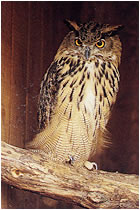
FLORA AND FAUNA
The Park territory is interested by the presence
of seventeen Common Interest
Sites (C.I.S) and by a Special
Protection Zone (S.P.Z.), which coincides
with the Park confines and therefore it occupies
some areas considered interesting by the European
Union and recognized as internationally important.
The Sirente Velino Park belongs to the Mediterranean
biogeographic region, but has got very continental
origins. In the inside there are numerous types
of different natural habitat, some of which are
included into the Appendix of the European Union
Law 92/43. The presence of these different habitat
make the Park an important reserve of biodiversity
with a uncommon natural richness. The territory
is included between 600 m.l.s.m of the Aterno
Valley and the almost 2500 metres of the Velino
Mountain. The strong altitude grade and its exhibition
favours the presence of the different environmental
realities, it creates a vast natural ambient.
In fact, it goes from the repariale environment
of the medium Aterno Valley through the karstic
pastures plan, from the forest sides (according
to the typical schemes of the calcareous mountains
vegetation) through the gravelly inundation cones.
Besides, the particularly rigid climate favours
the permanence of snow until spring, favouring
the condition for vegetal species and animals
usually present on higher levels.
The flora is rich of endemic species, rare, interesting
or protected from regional and national laws.
Among the glacial wrecks we can find the rare
Alium lineare, the Arctostaphylos uva-ursi,
the Aster alpinus, the Linaria alpine,
the Silene acaulis and some saxifrages,
between the endemism, there is the Geum heterocarpum,
which lives only through the Canal Grassland on
the northern side of the Sirente crest; instead
the endemics of the Abruzzo Apennine are the Potentilla
apennina, the Centaurea ceratophylla,
the Valeriana aliunica, the Adonis distorta,
and the Ranunculus magellensis, between
the rare species there are the Nigritella widderi,
the Daphne mezereum, the Fritillaria
tenella, the Viola eugeniae, the Ptilotricum
cyclocarpum and the Gentiana lutea.
Significant is also the presence of medical plants
like Atropa belladonna, Viscum album,
Borago officinalis, Satureja Montana,
Digitalis ferruginea and the Convallaria
majalis. It is also important the abundance
of fruit-bearing, between which we can remember
the Rubus idaeus, Fragaria Vesca,
Rosa canina, Pyrus spp., Malus
spp., Sorbus spp., Amelanchier ovalis,
Cotoneaster nebrodensis, Prunus avium,
Ribes rubrum, Ribes alpinum and
the Ribes uva –crispa. Between the
trees there is the presence of some nucleus relicts
of Betula pendula, Ilex aquifolium
and Taxus baccata. The mostly extended
woods are the one of Fagus sylvatica, with
many other species of trees through the medium
altitudes, the beech-woods, sporadic on Velino
Mountain, are instead present on Pezza Planes;
a wide and continuous wood its extended through
twelve km from Anatella, near Rovere, to Gagliano
Aterno. There are also oak-plantetion mixed essentially
to Quercus cerris, Acer spp., Corylus
Avellana, Salix spp., Ostrya carpinifolia,
Populus tremula, these woods can also be
characterized by significant dimensions as the
one of the right versant of Aterno Valley. Magnificant
centuries-old trees can be found anywhere into
the Park, beech into Anatella and to Capo Pezza,
oaks into Aterno Valley, and into Santa Maria
in Valle Porclaneta. It must be noted the intense
human activity, that, principally into the past,
has changed and has intervened on natural environment,
either in negative either in positive way.
The entire area presents this following vegetal
composition: about 25% of decidual woods, 25%
of steppes, 10% of humid prairies and mesophyte,
10% of heaths, scrubs fingange and garighe, 7%
of agricultural ground, 5% of alpine and subalpine
prairies, and less numerous of water corps internal
stagnant and current, cereal extensive cultivation,
evergreen woods, rocky habitats and forest monoculture
systems.
Fauna is also as rich, besides being the Park
an important connecting linkage zone between many
national parks and natural reserves and the faunal
reservoirs of the Abruzzo National Park. The territory
offers vast areas of vertebratelogic interest
with a significant extension and continuity. Through
the last years there have been an increment of
signs of presence of big carnivorous such as:
Ursus arctos, Canis lupus and Felys
sylvestris indicators of the nature grade
of the area. Some other important presences are,
among the Mammalia: Hystrix cristata, Martes
martes, Sus scrofa, Capreolus capreolus,
Cervus elaphus (reintroduced), Lepus
europaeus; among the Aves: Aquila chrystaeus,
Falco biarmicus, Accipiter nisus,
Falco tinnunculus, Buteo buteo,
Accipiter gentiles, Bufo bufo, Otus
scops, Asio otus, Dendrocopus major,
D. minor, D. medius, Picus viridis,
Montifringilla nivalis, Pyrrhocorax
pyrrhocorax; Gyps fulvus, and the Corvus
corax are the result of two reintroduction
projects of the Oriented Natural Reserve of the
Velino Mountain; the presence of humid and temporary
or persistent puddles allow the presence of migratory
birds such as: Ciconia ciconia, Grus
grus, Ardea cinerea, Ardea purpurea,
and some anatidi (Anas spp., Aythya
fulugula); among the Anphibia and Reptilia
it is worthy to be noted the presence of Salamandra
salamandra, Triturus cristatus, Triturus
vulgaris, Bombina variegata, Rana
esculenta, and of the rare and endemic Vipera
ursinii.
The entomological importance of the Sirente Velino
Park is well known by the specialists for its
numerous presence of rare species relict and endemic
,which live in altitude, and testify the good
level of health of the natural environment; the
Park area is also “Patria tipica”
for many entomological species, patria tipica
is the zone where the specie has been described
for the first time; well known by the entomologist
are the works of Leoni and D’Amore Fracassi
who have effectuated their research on the Sirente
Mountain at the beginning of the century. The
entomological species mostly representatives are:
Parnasius Apollo, Decticus aprutianus,
Otiorhynchus sirentensis, Otiorhynchus
leonii, Orobitis cyaneus, Tropiphorus
imperialis, Chiloneus lonai, Carabus
cavernosus and the Rhadinopsylla escantha.
Into the Sirente Velino Park, nearby the natural
“punctiform” values, endemism, glacial
relicts, rare species inscribed into the regional,
national and international “Red List”,
species into their area limits, we can find the
wonderful rocky environment of the Aielli Celano
Gorges or notorious altitude prairies of the Sirente
Velino, into the undoubted complex value, given
by the continuity of their extension, such as
beech-wood and mixed oaks.
From: Natural
Resources in the Sirente Velino Park
Synthesis: Park Archive Documentation
|
 |

